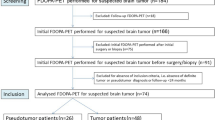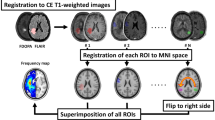Abstract
Aim
To investigate the progression-free survival (PFS) and the overall survival (OS) in a population affected by primary brain tumors (PBT) evaluated by [18F]-l-dihydroxyphenylalanine ([18F] FDOPA) positron emission tomography/computed tomography (PET/CT).
Materials and methods
133 subjects with PBT (65 women and 68 men, mean age 45 ± 10 years old) underwent 18F FDOPA PET/CT after treatment. Of them, 68 (51.2%) were Grade II, 34 (25.5%) were Grade III and 31 (23.3%) were Grade IV. PET/CT was scored as positive or negative and standardized uptake value ratio (SUVr) was calculated as the ratio between SUVmax of the lesion vs. that of the background. Patients have been observed for a mean of 24 months.
Results
The outcome of [18F] FDOPA PET/CT scan was significantly related to the OS and PFS in Grade II gliomas. In Grade II PBT, the OS proportions at 24 months were 100% in subjects with a negative PET/CT scan and 82% in those with a positive scan. Gehan–Breslow–Wilcoxon test showed a significant difference in the OS curves (P = 0.03) and the hazard-ratio was equal to 5.1 (95% CI of ratio 1.1–23.88). As for PFS, the proportion at 24 months was 90% in subjects with a negative PET/CT scan and 58% in those with a positive scan. Gehan–Breslow–Wilcoxon test showed a significant difference in the OS curves (P = 0.007) and the hazard-ratio was equal to 4.1 (95% CI of ratio 1.3–8). We did not find any significant relationship between PET outcome and OS and PFS in Grade III and IV PBT.
Conclusions
A positive [18F] FDOPA PET/CT scan is related to a poor OS and PFS in subjects with low-grade PBT. This imaging modality could be considered as a prognostic factor in these subjects.





Similar content being viewed by others
References
Weller M, van den Bent M, Tonn JC, Stupp R, Preusser M, Cohen-Jonathan-Moyal E, et al. European Association for Neuro-Oncology (EANO) guideline on the diagnosis and treatment of adult astrocytic and oligodendroglial gliomas. Lancet Oncol. 2017;18:e315–e329329. https://doi.org/10.1016/s1470-2045(17)30194-8.
Ledezma CJ, Chen W, Sai V, Freitas B, Cloughesy T, Czernin J, et al. 18F-FDOPA PET/MRI fusion in patients with primary/recurrent gliomas: initial experience. Eur J Radiol. 2009;71:242–8.
Kondziolka D, Lunsford LD, Martinez AJ. Unreliability of contemporary neurodiagnostic imaging in evaluating suspected adult supratentorial (low-grade) astrocytoma. J Neurosurg. 1993;79:533–66.
Jansen EP, Dewit LG, van Herk M, Bartelink H. Target volumes in radiotherapy for high-grade malignant glioma of the brain. Radiotherapy and oncology. J Eur Soc Ther Radiol Oncol. 2000;56:151–6.
Cicone F, Filss CP, Minniti G, Rossi-Espagnet C, Papa A, Scaringi C, et al. Volumetric assessment of recurrent or progressive gliomas: comparison between F-DOPA PET and perfusion-weighted MRI. Eur J Nucl Med Mol Imaging. 2015;42:905–15. https://doi.org/10.1007/s00259-015-3018-5.
Fan GG, Deng QL, Wu ZH, Guo Q. Usefulness of diffusion/perfusion-weighted MRI in patients with non-enhancing supratentorial brain gliomas: a valuable tool to predict tumour grading? Br J Radiol. 2006;79:652–8.
Calabria F, Chiaravalloti A, Di Pietro B, Grasso C, Schillaci O. Molecular imaging of brain tumors with 18F-DOPA PET and PET/CT. Nucl Med Commun. 2012;33:563–70. https://doi.org/10.1097/MNM.0b013e328351d566.
Lapointe S, Perry A, Butowski NA. Primary brain tumours in adults. Lancet (London, England). 2018;392:432–46. https://doi.org/10.1016/s0140-6736(18)30990-5.
Louis DN, Perry A, Reifenberger G, von Deimling A, Figarella-Branger D, Cavenee WK, et al. The 2016 World Health Organization Classification of Tumors of the Central Nervous System: a summary. Acta Neuropathol. 2016;131:803–20. https://doi.org/10.1007/s00401-016-1545-1.
Chen JW, Zhou CF, Lin ZX. The influence of different classification standards of age groups on prognosis in high-grade hemispheric glioma patients. J Neurol Sci. 2015;356:148–52.
Chaichana KL, Jusue-Torres I, Navarro-Ramirez R, Raza SM, Pascual-Gallego M, Ibrahim A, et al. Establishing percent resection and residual volume thresholds affecting survival and recurrence for patients with newly diagnosed intracranial glioblastoma. Neuro-oncology. 2014;16:113–22.
World Medical Association Declaration of Helsinki. ethical principles for medical research involving human subjects. JAMA. 2013;310:2191–4. https://doi.org/10.1001/jama.2013.281053.
Villani V, Carapella CM, Chiaravalloti A, Terrenato I, Piludu F, Vidiri A, et al. The role of PET [18F]FDOPA in evaluating low-grade glioma. Anticancer Res. 2015;35:5117–222.
Chiaravalloti A, Fiorentini A, Villani V, Carapella C, Pace A, Di Pietro B, et al. Factors affecting (1)(8)F FDOPA standardized uptake value in patients with primary brain tumors after treatment. Nucl Med Biol. 2015;42:355–9. https://doi.org/10.1016/j.nucmedbio.2015.01.002.
Rose S, Fay M, Thomas P, Bourgeat P, Dowson N, Salvado O, et al. Correlation of MRI-derived apparent diffusion coefficients in newly diagnosed gliomas with [18F]-fluoro-l-dopa PET: what are we really measuring with minimum ADC? AJNR Am J Neuroradiol. 2013;34:758–64.
Wen PY, Macdonald DR, Reardon DA, Cloughesy TF, Sorensen AG, Galanis E, et al. Updated response assessment criteria for high-grade gliomas: response assessment in neuro-oncology working group. J Clin Oncol. 2010;28:1963–72. https://doi.org/10.1200/jco.2009.26.3541.
Lizarraga KJ, Allen-Auerbach M, Czernin J, DeSalles AA, Yong WH, Phelps ME, et al. (18)F-FDOPA PET for differentiating recurrent or progressive brain metastatic tumors from late or delayed radiation injury after radiation treatment. J Nucl Med. 2014;55:30–6. https://doi.org/10.2967/jnumed.113.121418.
Karunanithi S, Sharma P, Kumar A, Gupta DK, Khangembam BC, Ballal S, et al. Can (18)F-FDOPA PET/CT predict survival in patients with suspected recurrent glioma? A prospective study. Eur J Radiol. 2014;83:219–25. https://doi.org/10.1016/j.ejrad.2013.09.004.
Soffietti R, Abacioglu U, Baumert B, Combs SE, Kinhult S, Kros JM, et al. Diagnosis and treatment of brain metastases from solid tumors: guidelines from the European Association of Neuro-Oncology (EANO). Neuro-oncology. 2017;19:162–74. https://doi.org/10.1093/neuonc/now241.
Adams MC, Turkington TG, Wilson JM, Wong TZ. A systematic review of the factors affecting accuracy of SUV measurements. AJR Am J Roentgenol. 2010;195:310–20. https://doi.org/10.2214/ajr.10.4923.
Schiepers C, Chen W, Cloughesy T, Dahlbom M, Huang SC. 18F-FDOPA kinetics in brain tumors. J Nucl Med. 2007;48:1651–61. https://doi.org/10.2967/jnumed.106.039321.
Nioche C, Soret M, Gontier E, Lahutte M, Dutertre G, Dulou R, et al. Evaluation of quantitative criteria for glioma grading with static and dynamic 18F-FDopa PET/CT. Clin Nucl Med. 2013;38:81–7. https://doi.org/10.1097/RLU.0b013e318279fd5a.
Albert NL, Weller M, Suchorska B, Galldiks N, Soffietti R, Kim MM, et al. Response assessment in neuro-oncology working group and European Association for Neuro-Oncology recommendations for the clinical use of PET imaging in gliomas. Neuro-oncology. 2016;18:1199–208. https://doi.org/10.1093/neuonc/now058.
Murphy ES, Leyrer CM, Parsons M, Suh JH, Chao ST, Yu JS, et al. Risk factors for malignant transformation of low-grade glioma. Int J Radiat Oncol Biol Phys. 2018;100:965–71. https://doi.org/10.1016/j.ijrobp.2017.12.258.
Smith JS, Alderete B, Minn Y, Borell TJ, Perry A, Mohapatra G, et al. Localization of common deletion regions on 1p and 19q in human gliomas and their association with histological subtype. Oncogene. 1999;18:4144–52. https://doi.org/10.1038/sj.onc.1202759.
Acknowledgements
The authors wish to thank Tiziana Martino (IRCCS Neuromed, Pozzilli, IT) for data collection.
Funding
The authors have nothing to disclose.
Author information
Authors and Affiliations
Corresponding author
Additional information
Publisher's Note
Springer Nature remains neutral with regard to jurisdictional claims in published maps and institutional affiliations.
Rights and permissions
About this article
Cite this article
Chiaravalloti, A., Esposito, V., Ursini, F. et al. Overall survival and progression-free survival in patients with primary brain tumors after treatment: is the outcome of [18F] FDOPA PET a prognostic factor in these patients?. Ann Nucl Med 33, 471–480 (2019). https://doi.org/10.1007/s12149-019-01355-8
Received:
Accepted:
Published:
Issue Date:
DOI: https://doi.org/10.1007/s12149-019-01355-8




